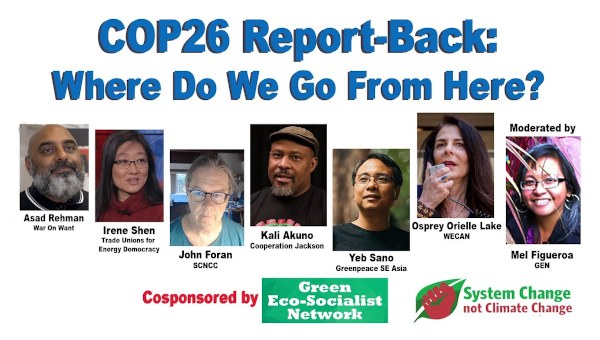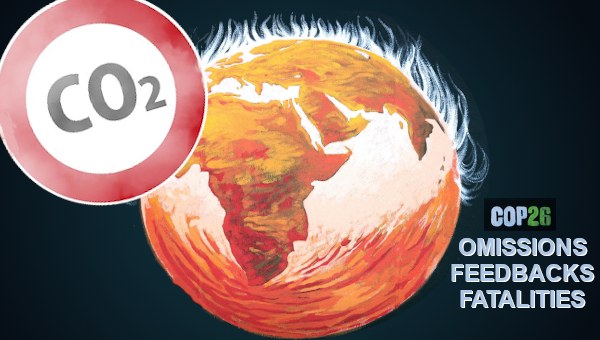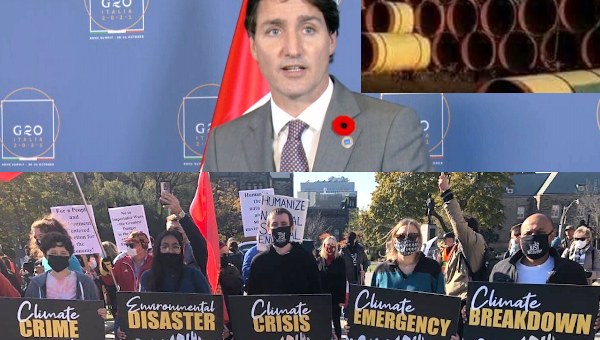COP26 Gives It Up to the Capitalists
The Glasgow Conference (COP26) should have given priority to 1) making good on the promise of the “developed” countries to contribute to the Green Climate Fund, from 2020 onwards, at least one hundred billion dollars a year to help the global South meet the climate challenge1; 2) forcing these same countries to intervene financially to cover the enormous “loss and damage” caused by warming, especially in the “least developed countries” and small island states; 3) “raising the climate ambitions” of governments to achieve the adopted COP21 (Paris, 2015) goal of “keeping the temperature increase well below 2°C while continuing efforts not to exceed 1.5°C compared to the pre-industrial period.”
The balance sheet is clear: on paper, Glasgow clarifies the ambiguous Paris goal by making it more radical (1.5°C is now the target) and mentions the responsibility of fossil fuels. However in practice, the conference did not take any steps to stop the catastrophe. A “step in the right direction,” some said. On the contrary: obsessed with the post-Covid neoliberal recovery and their geostrategic rivalries, the masters of the world decided to: 1) postpone the promise of one hundred billion for the Green Fund; 2) say no to compensation for “loss and damage”; 3) leave the field almost completely free for fossil fuels; 4) consider climate stabilization as a market for “carbon offsets” and technologies; 5) endow this market with a global mechanism for trading “rights to pollute”; 6) last but not least, entrust the management of this market to finance… which means to the rich whose investments and lifestyles are the fundamental cause of global warming.
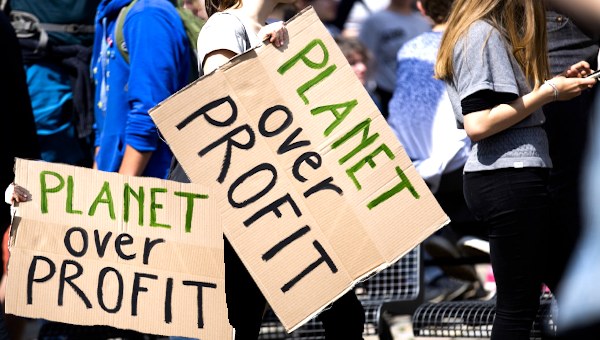
The 1.5°C Special Report: A Bombshell with Fallout at the IEA
The IPCC Special Report on 1.5°C (2019) had demonstrated the imperative need to stay below 1.5°C. The dangers of warming had been underestimated. Beyond 1.5°C, cascades of positive feedbacks threaten to tip the Earth into a “hothouse planet” regime. This would have dire consequences (including a rise in sea levels of 13 metres or more). The average surface temperature has risen by 1.1 to 1.2°C compared to the pre-industrial era. At the current rate, the 1.5°C mark will be passed by 2030… Conclusion: “net” global CO2 emissions must be reduced by at least 50 per cent before 2030, by 100 per cent before 2050 and become negative in the second half of the century.
The report was a bombshell. The leaders of the capitalist class can no longer bury their heads in the sand. Those with a modicum of brains have to admit that global warming can spiral out of control to the point of endangering their system. In this context a capitalist policy that claims to be “based on the best science,” even when carried by neoliberals like Boris Johnson, could not possibly maintain the ambiguity of the Paris agreement. The British presidency of COP26 proposed that a maximum of 1.5°C should be the sole target, and this clarification was ratified by the Conference.
The IPCC is explicit: the burning of fossil fuels plays a key role in warming. As a result, the shockwaves of the 1.5°C report were felt even by the International Energy Agency. In 2021, it issued a report that clearly states that “carbon neutrality” in 2050 requires drastic measures in the very short term: a ban from 2021 on the development of new oil and gas fields, the opening of new coal mines, the expansion of existing coal mines, or the authorization of the construction of new coal-fired power stations; the abandonment of coal from 2030 in the “advanced” economies; and the closure of all coal- and oil-fired power stations worldwide from 2040.2
This report was also a bombshell. The Agency had always developed a very progressive vision of “transition.” Now it was suddenly advocating a radical shift toward a “green capitalism” organized around renewables. Just as it could not maintain the ambiguity of Paris, the Glasgow summit could not continue to hide the responsibility of fossils. Under pressure from the energy sector and major users, every COP since 1992 had avoided the subject! This silence was no longer tenable. The British presidency submitted a draft declaration to delegates calling on parties to “accelerate the phasing-out of coal and subsidies for fossil fuels.” It will be shown later how this text was neutralized, but the mention of fossils remains in the final version.
Closing the Gap: a more daunting challenge every year
The Paris agreement created a large gap between the goal (“keeping the temperature increase well below etc.”) and the national climate plans, or “Nationally Determined Contributions” (NDCs). On the basis of these NDCs, the IPCC projected a temperature increase of about 3.5°C in 2100. To reduce this “emissions gap,” the COP21 adopted the principle of a review every five years, to “raise ambitions.”
In September 2020, the gap, all gases included, is estimated at between 23 and 27 GtCO2 equivalent.3 This gap must be eliminated before 2030 to stay below 1.5°C. Global emissions must therefore be halved. With the 2020 summit cancelled (pandemic), the governments decided to make another effort to “raise the ambitions” for Glasgow. The result: an additional 3.3 to 4.7 Gt of reductions. On this basis, the scientific network Climate Action Tracker projects a warming of +2.4°C (range: +1.9 to +3°C).4
Johann Rockström, director of the Potsdam Institute, delivered the ten key messages of the latest science to the COP. The first is that global emissions of CO2 alone need to be reduced each year by 2Gt (5%) by 2030 to have a 50/50 chance of staying below 1.5°C, and by 4Gt (10%) to have a two-thirds chance of staying below 1.5°C. A similar reduction is required for methane and nitrous oxide. There is no hope of achieving this at a five-yearly rate of NDC revision. Glasgow, therefore, decided to move to an annual rate. Seen from afar, this seems to leave a slender chance of success. Seen from up close, it is an illusion.
First: climate justice must be taken into account. Reductions of 5 and 10 per cent are global targets, to be modulated to take account of the “differentiated responsibilities” of countries. Rockström presented the most recent assessment on the subject: the richest one per cent of the world’s population must divide its emissions by thirty, while the poorest 50 per cent can multiply them by three. This clearly shows that the climate is a class issue, a major issue in the conflict between the possessing minority and the dispossessed majority.
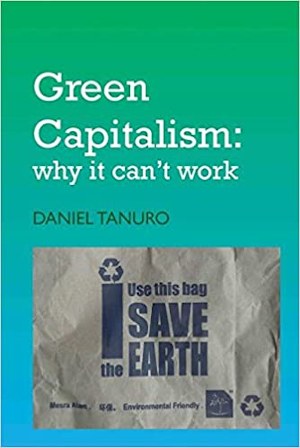
Second: a reduction of 2 or 4 Gt/year is linear in mathematical terms, but not in economic, social, and political terms. The more emissions are reduced (or reductions are attempted) and the shorter the timeframe, the more emissions reduction runs up against capitalist demands for growth and profit. This is very concrete: in the energy sector, the bosses are putting the brakes on fossil fuel investments, to limit the “stranded assets.” As fossil fuels cover more than 80 per cent of the needs, a peak in energy supply will probably precede the peak in demand. Hence, high prices.5 This is good for the fossil fuel companies, but it fuels inflation, frustrates the post-covid recovery, and weighs heavily on the working classes. They can fight back or they can give their votes to national-populists. Both options create instability. Calming prices and avoiding shortages would require boosting fossil fuel production. China has done it for coal, and Biden has asked (unsuccessfully) Saudi Arabia and Russia to do it for oil. But boosting fossil fuels equals boosting emissions. It’s a squaring of the circle.
An Insurmountable Contradiction, a Source of Chaos
China and the United States issued a joint statement at the COP. It will be of no use in breaking the deadlock. It is mainly a statement for the sake of appearances. The two great powers have an interest in posing together as the guarantors of the world’s stability and its climate. Perhaps they will try to collaborate on a partial aspect of climate policy (methane emissions?). But the underlying tensions are very strong and tend to deepen the conflicts. In the US, the Democratic majority is hanging by a thread with senior US Senator Joe Manchin being the loyal friend of coal. The Republicans have won the governorship of Virginia, hope to win the mid-term elections, and are campaigning against higher fuel prices. Their victory would change a lot! In China, the stability of the bureaucracy depends on the progress of the average standard of living on the one hand, and on nationalist exaltation on the other. The revival of coal does not prevent the rise in oil prices. There are many reasons for Beijing to continue to turn inward, accelerating its plans to reclaim Taiwan. All this is very unstable.
Wherever you look at the problem, you come up against the impossibility of the capitalist energy transition: you cannot at the same time revive a growth economy based on 80 per cent fossil fuels, replace fossil fuels with renewables, and drastically reduce emissions in the very short term. It is physically impossible. Either we reduce production to achieve the transition, or we sacrifice the transition to GDP growth. However, as Joseph Schumpeter said “capitalism without growth is a contradiction in terms.” Conclusion: the contradiction is insoluble, except through a revolutionary systemic change. As long as this historical possibility does not become a concrete possibility, the contradiction will become more and more serious with every attempt to reduce emissions.
Each capitalist tries to shift the burden to their competitors and to the workers. Each capitalist class uses its state to shift the burden to rival states and to the working classes. And the most polluting states are imperialist states that dominate the poorest. Consequently, the ecological/climate crisis will be combined with serious economic, social and political (and even military) upheavals along the following lines: 1) deepening social tensions, growing crisis of regime legitimacy, growing political instability, and an increased tendency toward authoritarianism; 2) neo-colonial policies of increasing brutality toward the peoples of the South, especially migrants, and especially women; 3) more acute rivalry between capitalists and between capitalist states, in particular; and 4) growing geostrategic tensions between the US and China. To believe that such a context would be conducive to the annual increment of climate agreements that are equal to the challenge is to believe in Father Christmas.
State Regulation Could Save Time, but…
Let’s insist on this point: there is no structural solution without a global decrease in production, consumption, and transport, modulated with respect for social justice. It is imperative to “produce less, transport less, consume less and share more,” (especially the wealth and the necessary working time).6 A capitalist policy of regulation, with an increased role for the state, is therefore not an alternative to the crisis. At the same time, it could alleviate the difficulty. But here is a second contradiction: capital does not want this policy.
The Montreal Protocol on the protection of the ozone layer provided an example of effective regulation. Signed in 1987 and implemented two years later, it organized the end of the production and use of CFCs (chlorofluorocarbons), adopted a timetable, and created a global fund (financed by the rich countries) to help the South. Twenty years later, emissions had fallen by about 80 per cent, and the World Meteorological Organization noted that the stratospheric ozone layer was beginning to recover in earnest.
This precedent could inspire action in the climate field. This is especially so since there is, so to speak, a precedent within a precedent: at their meeting in Kigali in 1996, the parties to the Ozone Protocol decided to eliminate HFCs (hydrofluorocarbons) as well. After Montreal, these HFCs had replaced CFCs. They do not destroy the ozone layer but, like CFCs, they have a radiative power more than a thousand times greater than CO2.7 The increased emissions of HFCs risked cancelling out the climate benefit that was an indirect consequence of the Ozone Layer Protocol. By deciding to phase out HFCs, governments made the recovery of the ozone layer consistent with the fight against climate change. The impact on global warming is not huge: by 2050, Kigali will have reduced greenhouse gas emissions by 90 GtCO2eq compared to projections, the equivalent of two years’ worth of emissions. But two years is important when every year that passes increases the probability of tipping from catastrophe to cataclysm.8
The same method would make it possible to rapidly reduce methane emissions. The greenhouse effect of this gas is much more powerful than that of CO2, and we are emitting more and more of it.9 Reducing emissions from ecosystems, agriculture (especially rice fields), and livestock farming cannot be done with a stroke of the pen. But eliminating leakage from the gas network, oil wells, and coal mines is relatively easy, does not require structural changes in the production system, and could reduce warming by 0.5°C compared to projections. No technological breakthroughs are needed, just forcing companies to make the necessary investments. But this is precisely where the problem lies: capitalists cannot be forced; they can only be encouraged by market mechanisms. This is the neoliberal doxa, enshrined in the Paris Agreement. We will see that Glasgow is more than ever ruling out any deviation from it.
Methane and Deforestation: Looking for Wasted Time?
There has been a lot of press coverage of the “methane deal.” At the COP, more than 100 countries promised to cut their emissions by 30% by 2030. If this were the case, warming in 2050 would be 0.2°C lower than projected (less than half the potential). But this is only a declaration of intent. There are no quotas per country, no funding for the countries of the South, no sanctions for non-compliance… The US, the EU, and Canada seem willing to act, it’s true, and it’s easy to see why: apart from Trump, the capitalist leaders are starting to panic. Limiting methane is a fairly easy course of action. But there is a long way to go: China and Russia have not signed the Glasgow text. It is also easy to understand why: they are two major emitters. Their absence will obviously serve as a pretext for capitalists in other countries to resist. As a result, it is doubtful that anything will be imposed on them. Instead, incentives and taxes will be used, in the hope that the cost of investment will fall below the price of the gas saved. The working classes will foot the bill.
Deforestation poses a similar dilemma. It would be another way of recovering some of the time wasted since Rio (1992), without affecting the structure of the productive apparatus. In Glasgow, 131 countries promised to invest $12-billion in a Global Forest Finance Pledge (GFFP). The aim is to “halt and reverse forest loss” by 2030. This pledge is very similar to the one made in New York in 2014: end deforestation by 2030, 50% reduction by 2020. In 2015-2017, deforestation rates rose by 41%! Some people see the GFFP positively because it is signed by Brazil and Russia, so more than 90 per cent of the Earth’s forests are covered. But this is no guarantee of effectiveness. Nor, above all, does it guarantee justice for indigenous peoples (whose rights and merits the GFFP emphatically recognises – but only in words).
In terms of effectiveness, it is important to note that the term “stopping and reversing forest loss” is not as unambiguous as it sounds. For some, removing a forest is NOT a “forest loss” … if the land is not then used for other economic sectors. Strange dialectic: one can cut down a forest without “forest loss” if it is to produce, in industrial monoculture, “carbon credits,” pellets, charcoal, or palm oil. This is Indonesia’s interpretation. It is home to one of the three great rainforest massifs. It is gradually being razed to the ground to plant palm trees. There was a moratorium, but two months before the COP, Jakarta refused to extend it. The Indonesian representatives in Glasgow signed the “stop forest loss,” and then said this: “Forcing Indonesia to (reach) zero deforestation in 2030 is clearly inappropriate and unfair,” development “must not stop in the name of carbon emissions or in the name of deforestation.” Stop forest loss, yes – stop deforestation, no… As far as indigenous peoples are concerned, the case of Brazil speaks for itself: is it really necessary to explain why the signing of the GFFP by the fascist Bolsonaro, who has declared war on the Amazon forest and the peoples who live there, has absolutely no credibility?10
Behind the Empty Promises, the sovereign power of the Deity “Market”
The COP sky was full of such agreements: on getting out of coal, on electric cars, on stopping cross-border investments in fossil fuels, or on stopping investments in fossil fuels on national territory. Some countries have even proudly announced their intention to green their military in order to “reduce their ecological footprint, particularly in the energy field.” It is a pity that sometimes ridicule does not kill – unlike armies.
All these “agreements” are empty promises. They are not binding, without concrete measures, without commitments by countries, without penalties for non-compliance. What is the point? Part of the answer is that governments are taking advantage of the spotlight on the COP to give themselves a green image and please their public opinion without harming the interests of capitalists…11 But this points to a deeper explanation: empty promises are in tune with neoliberal ideology, which ultimately knows only one decision-maker: the Market, i.e., profit, i.e., a minority of shareholders.
Coal and Other Fossils: a Very Clear Message
The trials and tribulations of the passage of the Glasgow agreement on coal and other fossils are very illuminating. First version (inspired by the IEA report, although softer): the COP “calls on Parties to accelerate the phase-out of coal and subsidies for fossil fuels.” Second version: the COP “calls upon Parties to accelerate the development, deployment and dissemination of technologies and the adoption of policies for the transition toward low-emission energy systems, including by rapidly scaling up clean power generation and accelerating the phase-out of unabated coal power and of inefficient subsidies for fossil fuels.” The air becomes breathable, but there is still talk of “phasing out” coal and “phasing out” fossil fuel subsidies. Third version: following an intervention by the Indian delegation, in the middle of the ratification meeting, “accelerating the phase-out” is replaced by “accelerating efforts toward the phasing-down.”
The role of the Modi government must be denounced. But it is obvious that India has acted not only for the whole coal planet, but also for the whole fossil planet, and with the support of all the capitalist gunmen.12 They were out in force at the COP to ensure, as one Finnish boss put it, that the conference “focuses on green growth rather than regulation, limitation and taxation.”13
Technically, the scope of the article on fossils is not very precise. “Emissions abatement” is a vague notion. According to the OECD, “[p]ollution abatement refers to technology applied or measure taken to reduce pollution and/or its impacts on the environment.” According to the G7, “unabated coal power generation refers to the use of coal that isn’t mitigated with technologies to reduce the CO2 emissions, such as Carbon Capture Utilisation and Storage (CCUS).” These definitions could open up broader possibilities for capitalists than the very expensive carbon capture and storage (CCS). On the one hand, capture with use (CCU), where CO2 from fossil fuel plants is used in other industries to make goods… from which the gas will eventually escape… sometimes very quickly (e.g., fizzy drinks). On the other hand, if governments consider CO2 removals by forests as emission reductions (we will see later that the US and the EU make just this amalgam!), then the abatement could simply consist of… planting trees.
Politically, however, the message is clear. In essence, the energy tycoons are telling governments, and the people: 1) Stop dreaming about getting out of fossil fuels, what counts is the development of “green” technologies; 2) Don’t interfere in preventing us from exploiting our coal mines and opening new ones, we are already good at accepting systems to reduce the impact of CO2; 3) Don’t bother imposing a minimum proportion of emissions to be “abated,” or one method of abatement rather than another; 4) If you really want to cut fossil fuel subsidies, cut the “inefficient” ones, which do not contribute to creating added value.14 This is the message that “our” governments ratified in Glasgow, without even being consulted on its final content. It is a real fossil-fuelled power grab.
Rush to Carbon Neutrality by 2050
The sovereign power of the market – i.e., profit, i.e., shareholders – is expressed not only in the “agreements,” but also in the rush by governments to achieve “carbon neutrality by 2050” (aka “zero net emissions”). The European Union, the United States, South Africa, Brazil, Russia, Japan, Saudi Arabia…: everyone has come up with a “strategy.” The closer Glasgow got, the more the promises of “net zero by 2050” multiplied… and the more these promises consisted in replacing short-term emission reductions with hypothetical long-term carbon absorptions. While shouting loudly that they were aiming for “carbon neutrality” in 2050,15 some governments were handing over an unchanged or even lower NDC than in 2015!16 It’s all about obfuscating the issue.
Climate Action Tracker (CAT) has set the record straight by distinguishing between climate policies actually implemented, NDCs raised, promises made at the COP, and “net zero” strategies.17 It is stated at the beginning of this article: on the basis of the policies pursued, the average temperature rise will be 2.7°C by 2100 (range: +2 to +3.6°C). The picture does not improve with the addition of the promises made at the COP and “net zero” agreements and strategies, quite the contrary. Overall, “no country has put in place sufficient short-term policies to put itself on a trajectory toward net zero.”
This general conclusion can be summarized as follows:
- with the 2030 targets, assuming they are met, the projection is +2.4 (range: +1.9 to +3°C);
- with the 2030 targets and the promises made during the COP, assuming delivery, the projection is +2.1 (range: +1.7 to +2.6°C);
- with the added promise of “carbon neutrality” in 2050 (‘“Optimistic scenario,” according to the report…), the projection is +1.8 (range +1.5 to +2.4°C). “This scenario is not compatible with the Paris Agreement” as it “does not rule out +2.4°C warming.”
Climate Action Tracker has further evaluated the “2050 net zero” strategies.18 The researchers chose ten parameters and adopted a colour code (from good to bad: green, orange, red). Conclusions: the strategies of Chile, Costa Rica, the European Union, and the United Kingdom are “acceptable”; those of Germany, Canada, the USA, and South Korea are “average”; those of Japan, China, Australia, and New Zealand are “poor”; all the others are “incomplete” (notably Brazil, South Africa, Russia, Saudi Arabia…). It is clear that most governments have jumped on the ’carbon neutrality’ bandwagon in order to paint themselves green and go unnoticed in Glasgow.
The assessment of the strategies of the developed countries and China is worth looking at. The EU is in the red on two parameters: unclear commitment to equity, and no distinction between emissions removals and reductions. Germany is twice in the orange and three times in the red: its “net zero” does not cover emissions from international aviation and shipping, and it does not exclude “carbon offsetting” outside national borders. The same red marks for the USA, which also mixes up absorption and reduction, and whose commitment to equity lacks clarity (what did you expect?). As for China, it is in the red on 6 parameters and in the orange on 3 others.
This analysis fully confirms the denunciations of eco-socialists and other activists: when they are not non-existent or completely hollow, “net zero” strategies are incomplete and, in the best case, deeply biased. All this talk of “net zero” has only served to put off indefinitely the bulk of the 19 to 23 GtCO2eq whose elimination over the next eight years will determine whether or not we can avoid exceeding 1.5°C of warming. Clearly, this is a scam, and the cause of this scam is crystal clear: let’s avoid all constraints, all regulation, all planning.
Let’s not Decide Anything, let’s create the Market that will decide
The IPCC 5th Assessment Report explicitly stated the following: “Climate models assume fully functioning markets and competitive market behaviour.”19 This assumption, in turn, presupposes the creation of a market with market instruments. Paris, in its Article 6, had adopted the principle of a “New Market Mechanism” to take over the mechanisms of the Kyoto Protocol. A series of inter-capitalist conflicts prevented the realization of this principle at COP25 (Madrid), which failed on this issue. But, hallelujah, Glasgow reached an agreement. All parties (states, regions, companies) will be able to trade pollution rights. These can be generated anywhere in the world through clean investments, tree plantations, conservation of existing forests, CO2 capture and sequestration (CCS), and CO2 capture and use (CCU).
Among the conflicts to be resolved: how to avoid double counting of emission rights (by the seller and the buyer); whether the rights generated under Kyoto will be convertible into the new system (the majority of these rights do not correspond to real emission reductions); whether the trade in rights will be taxed to help the countries of the global South to cope with the “loss and damage” they are experiencing as a result of global warming;20 There is not enough space here to examine all this in detail. Overall, “the Article 6 mechanisms create such such significant loopholes that they could eliminate any remaining opportunity to get the world on a 1.5C pathway.”21 The decisions taken by the COP may not be enough to avoid double counting. The compromise reached on the Kyoto rights – those generated in 2013 and after will be convertible – is a victory for the hot air merchants (hot air refers to false reductions). Especially in Bolsonaro’s Brazil, which has a lot of them.
A next step will be to list clean, duty-bearing investments. The European Union’s list (“Taxonomy,” in the jargon) will be fixed by the end of the year. The stakes are high: the “taxonomy” will pave the way for green finance. The question remains: will nuclear energy be included? Defining it as “sustainable energy” would be absolute nonsense. The only thing sustainable about this technology is the waste that no one knows what to do with. It will pollute the environment for tens of thousands of years or more. But… the market is fantastic. China, for example, is planning to build 150 reactors. From a capitalist point of view, which turns everything upside down (as Marx said), it would be an absolute nonsense to miss out on this prize money… a source of “sustainable” profits. Led by France, ten countries are campaigning for nuclear power to be included in the Taxonomy. Five others are opposed, including Germany. Who will win? Suspense until the decision.
Climate Finance: poor people, try to be attractive to investors!
The height of this criminal logic is reached when it comes to “climate finance.” It has two components: public flows and private flows. The former is, in turn, subdivided into two subcomponents: Green Funds and compensation for losses and damages. At the COP, the whole package was the subject of a plenary day: Welcome to the Finance Day!
On the subject of the Green Fund, the Chancellor of the Exchequer (British Finance Minister) said, in essence, OK, the North hasn’t delivered on its promise. Sorry about that. But we’re at 80 billion, we’ll get to a hundred from 2023, then we’ll exceed the target and that will make up for the shortfall in previous years. This gentleman did not say that there are only 20 billion in grants in the Green Fund. The rest are loans. The agreement promises double funding for adaptation to global warming from 2025 onwards, but without guarantees. A UN committee will report next year on progress toward the $100bn/year target. The main point is that the South is threatened with a new spiral of indebtedness.
The issue of loss and damage is even more explosive by far. Take the example of Somalia. It has contributed to 0.00026% of historical climate change… but is suffering repeated droughts, clearly attributable to warming. In 2020, 2.9 million people were severely food insecure. International aid is highly insufficient. Kenya, Ethiopia, Sudan, and Uganda are experiencing the same drama. Who will pay? And who will pay for future disasters? The NGO Christian Aid estimates that, with unchanged policies, climate change will cause the GDP of the poorest countries to fall by 19.6 per cent by 2050 and 63.9 per cent as an annual average by 2100. If we limit the temperature rise to 1.5°C, these figures would be -13.1 per cent and -33.1 per cent respectively. The bill for losses and damages will quickly rise to several thousand billion. The principle of financing by rich countries is enshrined in the UN Framework Convention on Climate Change, but imperialist governments plainly refuse to respect it. Period.
The miracle solution is supposed to come from private finance. Mark Carney, formerly of Goldman Sachs, former head of the Bank of England, Chairman of the G20 Finance Stability Board, has been appointed by the UN as a “special envoy” on climate finance. Just before the COP, he brought together several components of “green finance” in the Glasgow Finance Alliance for Net Zero (GFanz). GFanz is led by 19 CEOs of major financial companies, including Brian Moynihan of Bank of America, Larry Fink of BlackRock, Jane Fraser of Citigroup, Noel Quinn of HSBC, Ana Botín of Santander, and Amanda Blanc of Aviva. Its aim is to provide “a practitioner-led forum for financial firms to collaborate on substantive, cross-cutting issues that will accelerate the alignment of financing activities with net zero and support efforts by all companies, organizations, and countries to achieve the goals of the Paris Agreement.”
At the COP, GFanz was the star of Finance Day. The consortium is worth $130,000-billion. The Chancellor of the Exchequer tried to bluff everyone by praising this “historic wall of capital,” ready to come to the rescue of the planet and its climate. Translation: ready to finance “clean” investments, clean coal, green hydrogen, tree plantations, conservation of existing forests, CO2 capture and sequestration (CCS), and CO2 capture and use (CCU). Whatever greenwashing you want, as long as it pays off. Because the conditions are pretty clear: “To do that, investors need to have as much clarity as they do in the traditional financial metrics of profit and loss.” Poor people, try to be attractive to investors…
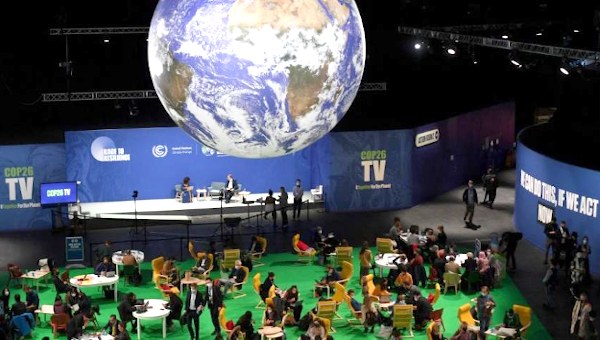
The NGO Reclaim Finance has ripped the green mask off these financiers. In bulk: GFanz’s benchmark (the UN’s Race to Zero criteria) does not mention fossils; Alliance members are not required to reduce their indirect emissions (so-called “Scope 3” emissions, which account for about 88 per cent of fossil-sector emissions); no absolute reduction of emissions is needed, a relative one is enough; none of the GFanz partners ban or limit the use of offsetting; as of mid-October 2021, 34 of the 58 members of the Asset Owner Alliance (one of the GFanz components) had no restrictions on investing in fossils.
A few months before COP21 (May 2015), François Hollande opened the business climate summit in Paris by saying, “Businesses are essential because they are the ones who will translate, through the commitments that will be made, the changes that will be necessary: energy efficiency, the rise of renewable energies, the ability to transport oneself with a mobility that does not consume energy [sic!], energy storage, the mode of construction of habitats, the organization of cities, and also the participation in the transition, in the adaptation of countries that are developing.”
We can only copy here the interpretation of this statement in “Too late to be pessimistic”: “Beloved capitalists, we, the politicians, offer you the planet, the cities and the forests, the soils and the oceans, we even offer you the market of the adaptation of the countries of the South to the catastrophe that you are imposing on them; everything is yours, take it: this is the message.”22
From the point of view of capital, it is wrong to say that COP26 is blah blah blah. It is rather a monstrous apotheosis of neoliberalism. This summit took a significant step forward on the road to the total commodification of the Earth, its ecosystems, and its inhabitants, for the benefit of finance and at the expense of Nature and the people.
In the Form of Conclusion
The political leaders all (or almost all) recognise this: the urgency is maximum, the risk is immeasurable, there is not a moment to lose. And yet, from one COP to the next, despite the light shed by “The best Science available.” The time to fight back is being wasted, and the march to the abyss is accelerating. This aberrant, hallucinatory, and frightening reality does not result from the imbecility of this or that official, nor from the plot of occult forces: it results from the fundamental laws of Capitalism, and these laws also corrupt the “best Science.” Based on competition for profit, this mode of production forces millions of capitalists, on pain of economic death, to make millions of investment decisions at every moment which aim to increase the productivity of labour through machines. The resulting tendential fall in the rate of profit is compensated by an increase in the mass of goods produced, an increase in the exploitation of labour power, and an increase in the exploitation of other natural resources. This system functions like an automaton out of all control. It carries with it, like a cloud, not only war – as Jaurès said – but also the potential for unlimited development, unlimited growth in inequality, and unlimited further ecological destruction.
It must be forcefully repeated: there is an insurmountable antagonism between prolonging this system and safeguarding the planet as an environment conducive to life and humanity. Therefore, as Lenin did when war broke out in 1914, we must, to begin with, and independently of the balance of power, dare to make a clear diagnosis: the situation is “objectively revolutionary.” With the Glasgow COP, a brief cycle of increasingly urgent warnings begins: either the convergence of social mobilizations will make it possible to begin to bridge the enormous gap between this objective situation and the level of consciousness and organization of the exploited and oppressed (the “subjective factor”), or the automaton will drive us ever deeper into a barbarism of unprecedented proportions. •
This article first published on the Fourth International website.
Endnotes
- Promise made during the Cancun COP in 2010.
- IEA, “Net Zero in 2050. A Roadmap for the Energy Sector”.
- Giga tonnes of greenhouse gases calculated as if they were all CO2.
- “Glasgow’s 2030 credibility gap.”
- Financial Times, 4 November 2021 “COP26: oil price soars even as the world turns against fossil fuel.”
- Daniel Tanuro, Trop tard pour être pessimistes. Ecosocialisme ou effondrement, Textuel, Paris, 2020.
- The radiative power of a gas is its ability to absorb and radiate the infrared radiation emitted by the Earth and thus contribute to the greenhouse effect that makes the planet suitable for life.
- Daniel Tanuro, « L’accord de Kigali sur le climat: de l’arbre des HFC à la forêt du CO2», Politique la revue.
- In the short term, the radiative power of methane is 80 times greater than that of CO2. But methane is quickly eliminated from the atmosphere (by chemical reaction with oxygen). Over a hundred years, its radiative power is estimated to be 30 times that of CO2.
- “Will the COP26 global deforestation pledge really save forests?” Kieran Mulvaney, National Geographic, 5 November 2021.
- For example, France is proud to have joined the Beyond Oil and Gas (BOGA) coalition. Together with eleven other countries (very small producers), it promises to stop extracting oil or gas… on its territory. It abstains from the coalition between Great Britain and others, who promise not to put any more public money outside their borders into fossil fuel installations without abatement. France’s absence from the latter coalition, and Britain’s from the former, is illuminated by the links between Paris and Total on the one hand, and London’s fossil interests in the North Sea on the other.
- See Global Witness’s investigation of the hundreds of fossil fuel gunmen at COP. Read also “In Glasgow, COP26 Negotiators Do Little to Cut Emissions, but Allow Oil and Gas Executives to Rest Easy”, Climate News, 12 November 2021: “Royal Dutch Shell and Chevron (…) participated under the banners of national delegations or industry groups. Saudi Arabia and other petrostates brought delegates from their oil companies, but so did Canada, which included a representative of Suncor, a top producer in the country’s tar sands.”
- Financial Times, 11 November 2021.
- The public subsidy for heating oil that exists in Belgium, for example, is completely “inefficient”…
- 2060 for China, 2070 for India.
- Carbon Action Tracker, op. cit.
- Climate Action Tracker, “Glasgow’s 2030 credibility gap: net zero’s lip service to climate action. Wave of net zero emission goals not matched by action on the ground.»
- Climate Action Tracker, “Net zero target evaluations.”
- AR5, GT3, Chap 6, p. 422.
- Financial Times, 11 November 2021.
- Press release of CLARA (Climate Land Ambition and Rights Alliance).
- op. cit.


